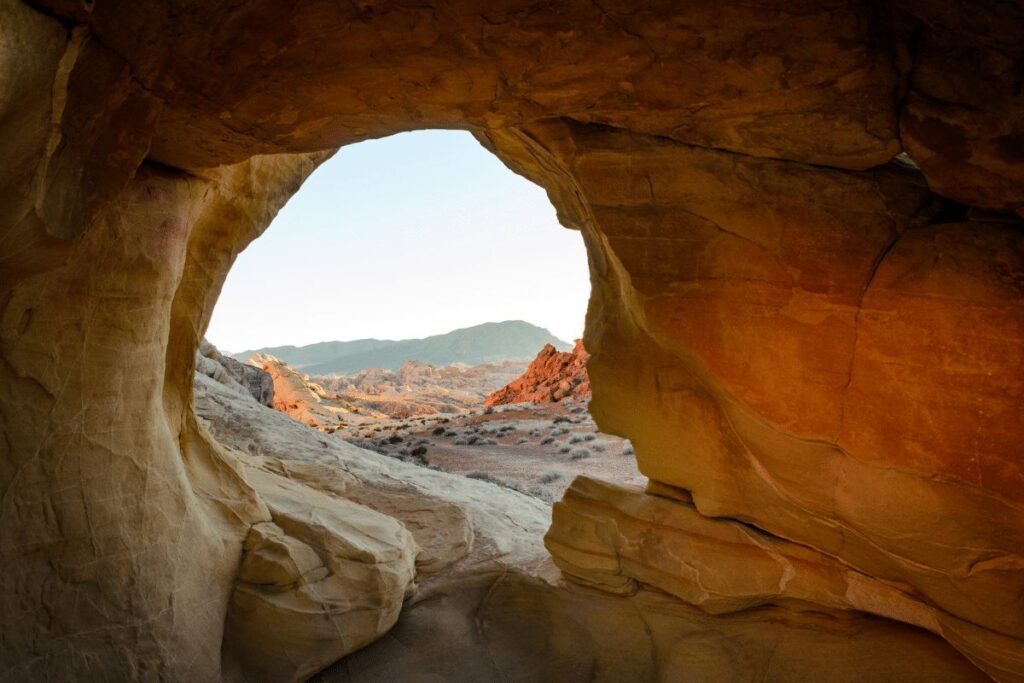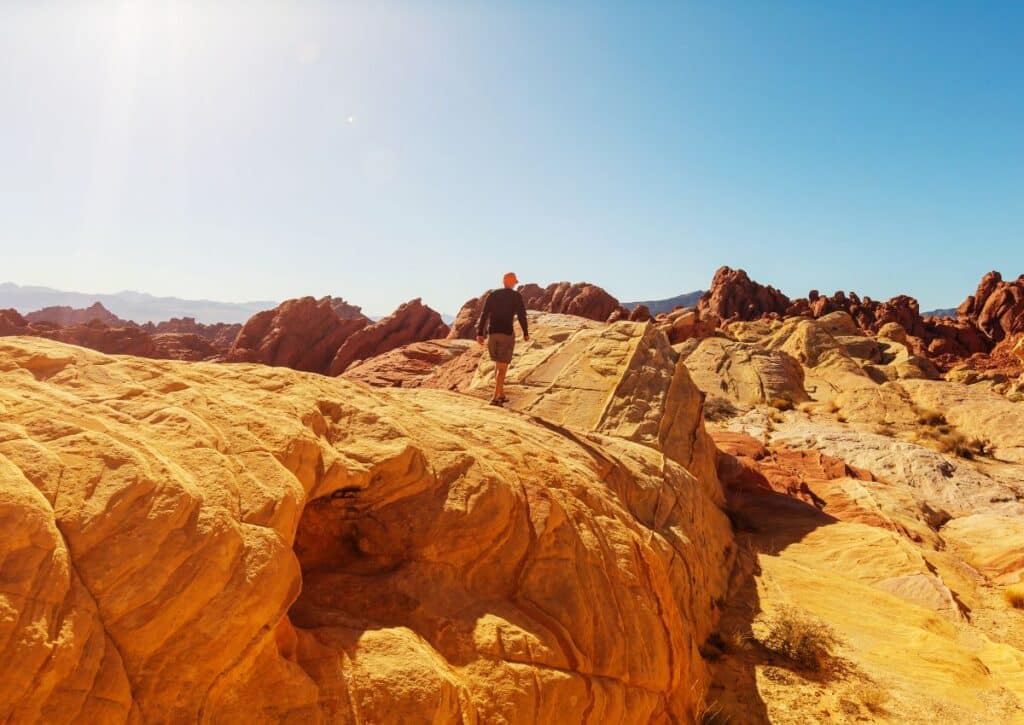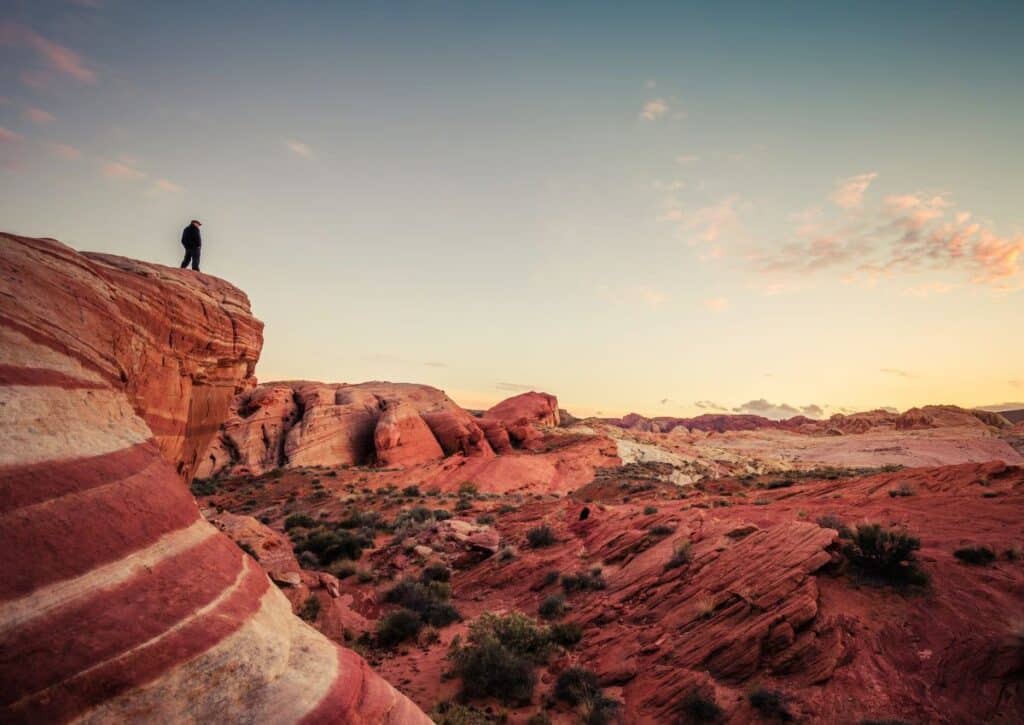Discover what Valley of Fire is famous for: breathtaking landmarks, ancient petroglyphs, challenging trails, and unique desert wildlife, all near Las Vegas!
Dive into the vibrant heart of Nevada’s oldest and largest state park, the Valley of Fire, named for its breath-taking crimson sandstone formations that ignite with the rising and setting sun.
Just an hour away from the electrifying city of Las Vegas, this natural sanctuary offers an invigorating retreat from city life.
Here, adventurers, history buffs, and nature enthusiasts alike will discover a treasure trove of experiences, from challenging trails and ancient petroglyphs to unique desert wildlife.
With its vivid landscapes and deep cultural roots, the Valley of Fire is a shining beacon of nature’s untouched splendor. Buckle up for an exhilarating journey through this iconic wonderland!
A Brief History of the Valley of Fire
Venture back in time as we unravel the thrilling saga of the Valley of Fire. This tale begins about 150 million years ago, during the Jurassic era when colossal dinosaurs roamed the earth.
Formation and Geology
The fiery red sandstone that adorns the park today is the remnants of massive shifting sand dunes from that time.
Over millennia, through the relentless forces of wind, water, and time, these dunes solidified into the stunning Aztec Sandstone formations we marvel at today.
Each ridge, each undulation in the rock speaks of an era long gone, etching the chronicles of time itself into the fiery red landscape.
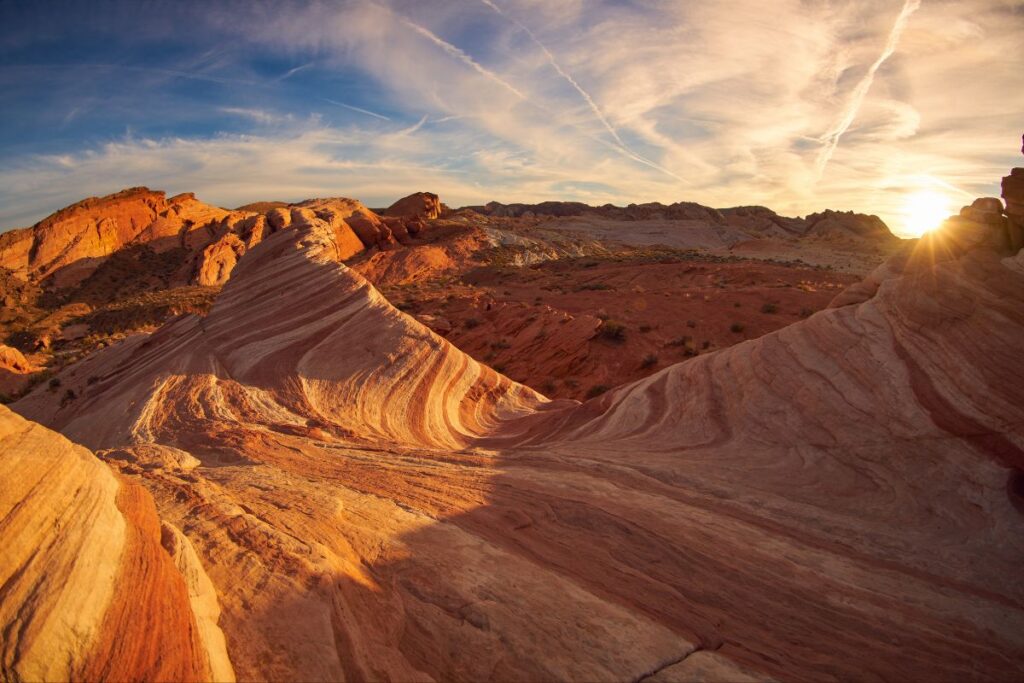
Culture and People of the Valley of Fire
The Valley of Fire also bears the marks of a rich cultural tapestry, woven by the native peoples who once called this harsh yet beautiful desert their home.
The Anasazi, ancestors of the modern Pueblo people, left behind a treasure trove of petroglyphs etched into the red rock faces.
These ancient symbols, dating back more than 2000 years, provide a tantalizing glimpse into a past civilization’s life and beliefs.
European settlers later discovered the valley, adding a new thread to its historical fabric.
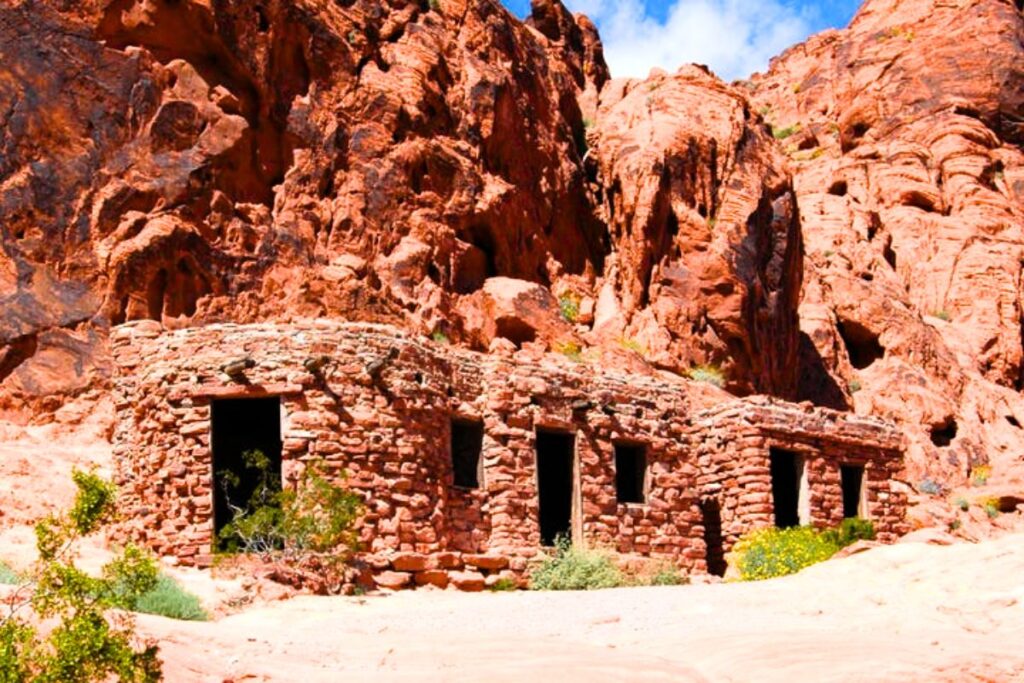
From serving as a backdrop for Hollywood films to becoming Nevada’s first designated State Park, the Valley of Fire has continued to evolve and captivate, merging natural beauty with human history in a spectacular desert panorama.
Iconic Landmarks and Scenic Vistas
The Valley of Fire is a canvas painted by nature’s master strokes, where each geological marvel and scenic vista tells its own unique tale.
Here are some must-visit iconic landmarks that are sure to leave you awe-inspired:
Elephant Rock: Nature’s Own Sculpture
Aptly named for its uncanny resemblance to a gigantic elephant, this naturally sculpted rock formation is a testament to the whimsical creativity of natural forces.
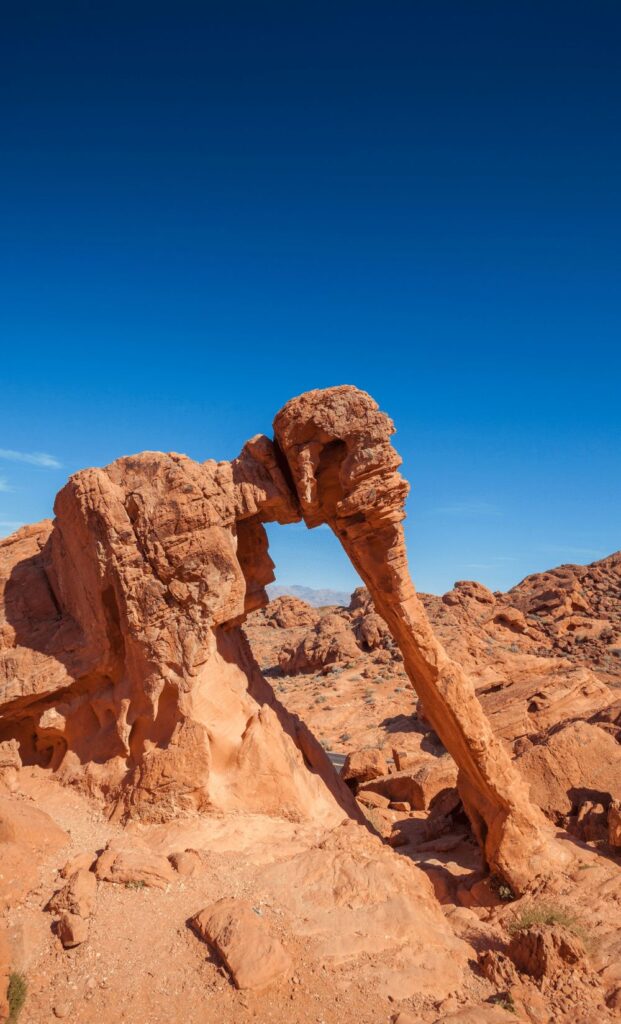
The ‘elephant’, complete with a trunk, appears ready to march into the horizon, adding a touch of whimsy to the rugged landscape.
The Fire Wave: A Sea of Color
The Fire Wave, with its undulating waves of vibrant red, orange, and pink sandstone, is a mesmerizing sight.
This unique formation, resembling a frozen wave, ignites the imagination and provides an unforgettable backdrop for photographers and nature lovers alike.
Rainbow Vista: A Palette of Natural Beauty
At Rainbow Vista, you’ll gaze upon a sweeping landscape that encompasses all the colors of the rainbow.
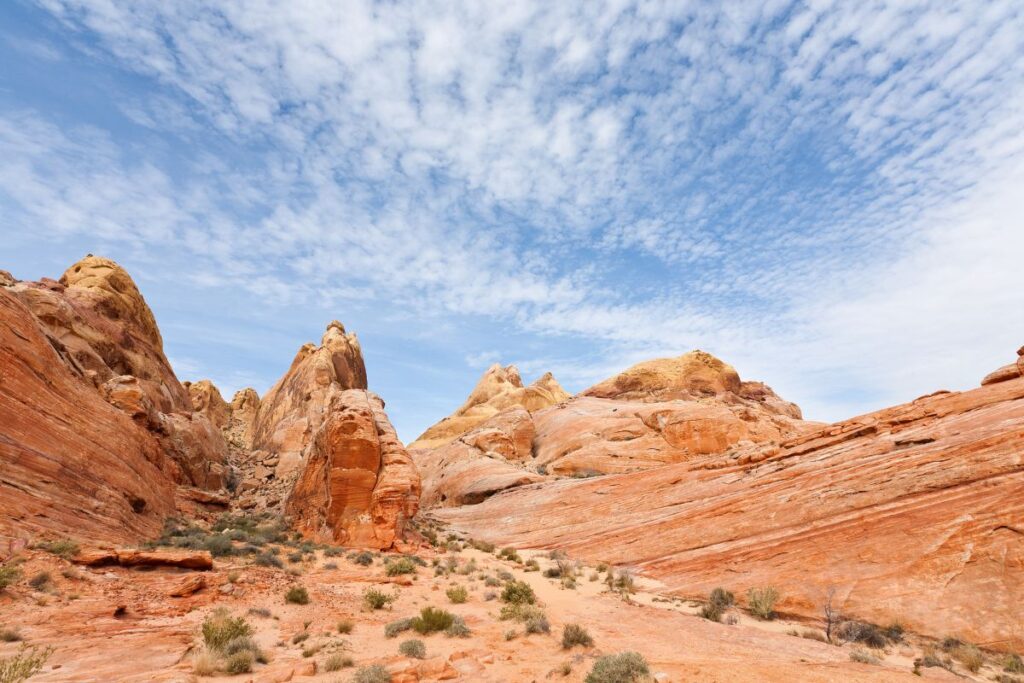
From the pink and red sedimentary layers of the sandstone to the vibrant desert flora, this location offers a truly panoramic view of the park’s diversity.
Arch Rock: The Gateway of the Desert
Resembling an ancient gateway, Arch Rock invites visitors to explore the mysteries that lie beyond.
Formed by centuries of erosion, this delicate arch is a visual spectacle and an iconic symbol of the park’s timeless beauty.
Atlatl Rock: A Window to the Past
Atlatl Rock is more than just a geological formation; it’s a historical artifact.
Housing some of the most prominent petroglyphs in the park, a climb up the installed staircase offers a close-up view of these ancient etchings.
Seven Sisters: The Spectacular Sentinels
Seven Sisters is a group of tall, red, eroded boulders surrounded by the barren desert landscape.
These monoliths stand as silent sentinels to the park’s history and provide a striking contrast to the flat desert floor.
White Domes: A Walk through Time
The White Domes area features contrasting white and red sandstone formations and the remnants of an old film set, offering visitors a walk through both geological and Hollywood history.
Hiking Trails in the Valley of Fire
Adventure awaits at every turn in the Valley of Fire, especially for those who love to explore on foot.
The park offers a rich array of trails, each with its unique allure and varying difficulty levels, providing a thrilling experience for both casual strollers and hardcore hikers.
Overview of the Hiking Options and Their Difficulty Levels
The Valley of Fire has a trail for every fitness level and interest. From easy, flat trails perfect for families and beginners to more challenging routes that test your endurance and offer rewarding views, there’s something for everyone.
Each trail unveils a different facet of the park’s diverse landscape, promising an exciting journey into nature’s wonderland.
White Domes Trail: A Journey Through Time
Step back in time as you embark on the White Domes Trail, a moderate 1.25-mile loop that’s as rich in history as it is in natural beauty.
As you navigate the scenic canyons and multi-hued sandstone formations, keep an eye out for remnants of the film “The Professionals,” shot here in the 1960s.
This is a journey where Hollywood glamour meets geological marvel, creating an unforgettable hiking experience.
Mouse’s Tank: A Historical Stroll
The Mouse’s Tank trail, named after a renegade Native American who used the area as a hideout in the 1890s, is an easy 0.75-mile round trip trail that’s like a walk through a living history museum.
Be sure to look for the petroglyphs, ancient rock carvings that offer a glimpse into the life of the indigenous people who once called this land home.
Fire Wave Trail: A Colorful Adventure
For a visually arresting hike, the Fire Wave Trail is a must.
This moderate 1.5-mile round trip trail takes you through a sea of swirling red, pink, and white sandstone, culminating in the iconic Fire Wave, a stunning geological formation that looks like a wave frozen in time.
This is nature’s artistry at its finest, a sight that will leave you awestruck.
Prospect Trail: The Desert Explorer’s Dream
For the more adventurous, the Prospect Trail offers a challenging yet rewarding hike.
This 5.5-mile one-way trail traverses the heart of the park, offering panoramic views of the Valley of Fire’s stunning landscape.
From sweeping sandstone formations to diverse desert flora, this trail is a true desert explorer’s dream.
Rainbow Vista Trail: A Painter’s Palette
The Rainbow Vista Trail, an easy 1-mile round trip, is like walking through a painter’s palette.
Here, the desert landscape explodes in a riot of color, with the sandstone formations showcasing hues of red, pink, yellow, and even violet.
This is nature’s canvas in its full glory, a sight that will fill your heart with joy and your camera with stunning shots.
Petrified Logs Loop: A Walk Through Prehistory
The Petrified Logs Loop is a short, easy 0.3-mile trail that takes you on a journey back to prehistoric times.
Here, you’ll find petrified logs, ancient remnants of trees turned to stone over millions of years.
Walking this trail is like being in a natural history museum, with the exhibits displayed under the open sky.
Silica Dome Trail: A Martian Landscape on Earth
The Silica Dome Trail, an easy 1.2-mile round trip, leads you to one of the most unique sights in the Valley of Fire.
The Silica Dome, a large, white, half-dome-shaped rock formation, is a stark contrast against the red sandstone that dominates the park.
Its otherworldly appearance has even led it to be used as a filming location for Mars scenes in movies.
Balancing Rock Trail: A Marvel of Nature
The Balancing Rock Trail is a short, easy 0.25-mile loop that leads to an awe-inspiring sight – a huge boulder delicately balanced on a pedestal of rock.
This natural marvel, shaped by millions of years of erosion, is a testament to the incredible forces of nature that have shaped the Valley of Fire.
Atlatl Rock Trail: Ancient Echoes
The Atlatl Rock Trail, a short, steep climb up a metal staircase, leads you to some of the most significant petroglyphs in the park.
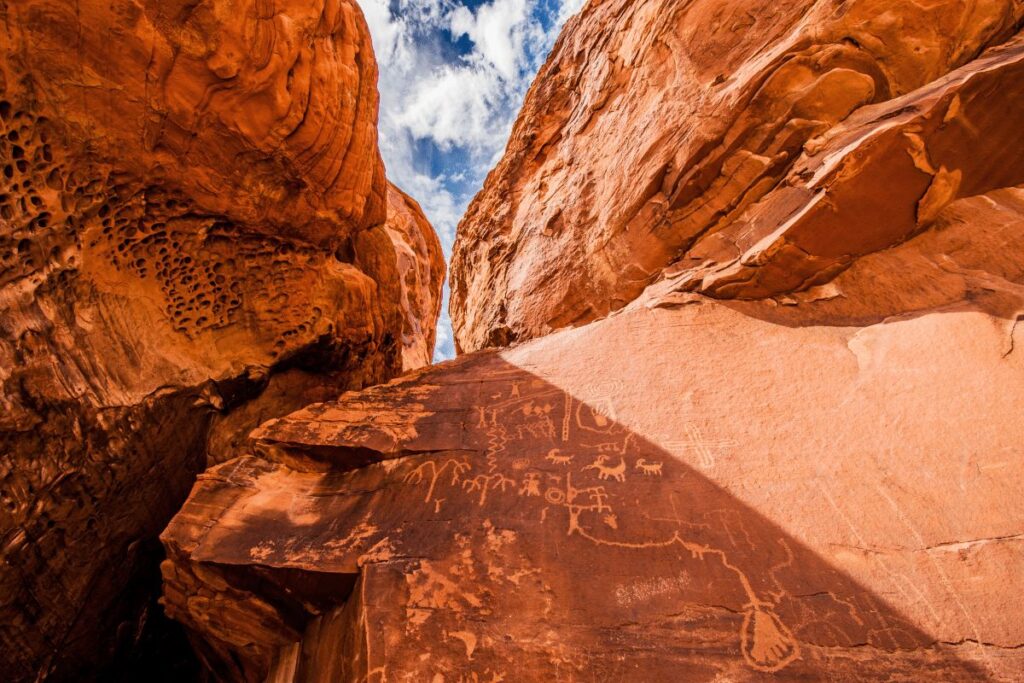
These ancient rock carvings depict atlatls, an ancient throwing spear that predates the bow and arrow. This trail offers not just a hike, but a journey back in time.
Also Read:
Tips for Hiking in the Desert
Hiking in the desert can be a thrilling adventure, but it’s essential to be prepared.
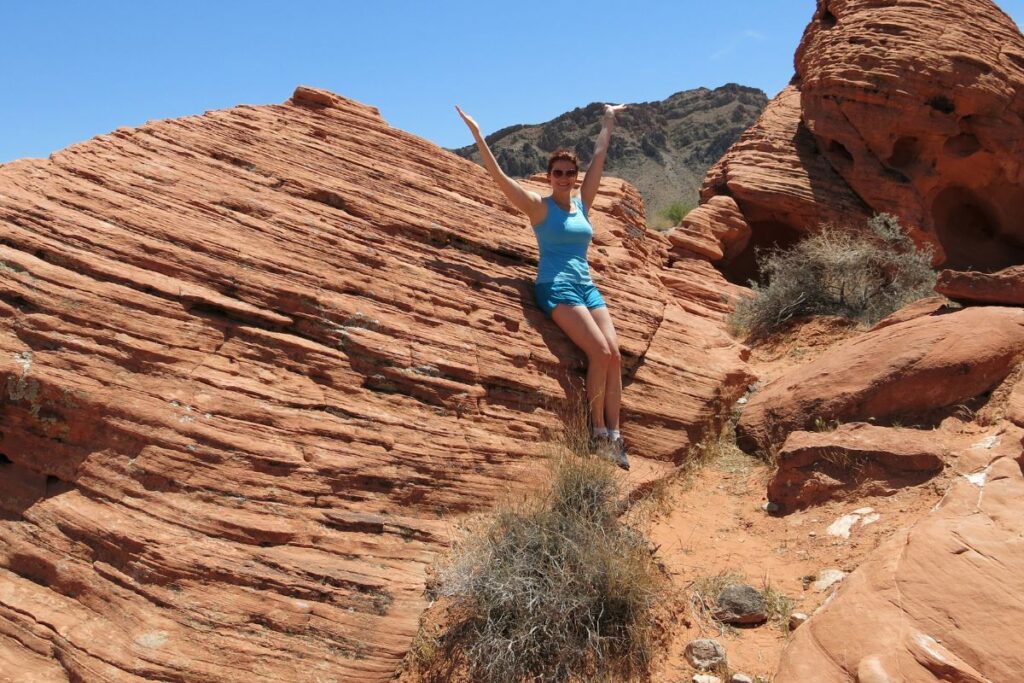
Always carry plenty of water and wear sun protection, such as a hat and sunscreen.
Check the weather before you start your hike, as conditions can change rapidly in the desert.
Follow the marked trails to protect the fragile desert ecosystem and to ensure your safety. Remember, the desert can be a harsh environment and it’s easy to get lost if you stray from the path.
Wear appropriate footwear that can handle the rough desert terrain. Lightweight, breathable hiking boots with good ankle support are ideal. Many trails are sandy or rocky, so proper footwear will help prevent injuries.
Also, keep in mind that many of the trails are exposed with little to no shade. If you’re not used to hiking in such conditions, consider starting your hike early in the morning or later in the afternoon to avoid the peak sun hours.
Hiking in the Valley of Fire is more than just a physical activity. It’s an exploration of natural beauty, geological wonders, and ancient history.
It’s an adventure that enriches the soul, connects you with nature, and leaves you with memories that will last a lifetime.
So strap on your hiking boots, pack your water bottle, and get ready to discover the wonders that await in this fiery desert paradise.
Wildlife and Flora: Life in the Desert
A desert might seem inhospitable at first glance, but a closer look reveals a world teeming with life.
The Valley of Fire is home to a remarkable array of wildlife and flora, each species having uniquely adapted to thrive in this challenging environment.
Flora: Plants that Thrive in the Desert
The Resilient Greenery
In the Valley of Fire, vegetation has developed remarkable adaptations to survive.
Plants here have to cope with arid conditions, extreme temperatures, and nutrient-poor soils. But they’ve risen to the challenge in incredible ways.
Creosote Bush and Burrobush
Dominating the landscape are the Creosote Bush and the Burrobush, both of which have evolved to conserve water and thrive in the desert heat.
Their small, waxy leaves minimize water loss, while their deep roots tap into the moisture hidden deep beneath the desert surface.
Cacti and Yuccas
Cacti and yuccas are other common sights, their fleshy bodies and spiny exteriors perfect for desert survival.
They not only store water in their tissues but also have a thick, waxy coating that reduces evaporation.
Desert Marigold and Indigo Bush
Adding a dash of color to the desert landscape are the Desert Marigold and Indigo Bush.
These flowering plants bloom in spring, providing a vibrant contrast to the fiery red sandstone.
Fauna: Animal Species and Their Adaptations
The Desert’s Diverse Inhabitants
The desert teems with life, from tiny insects scuttling underfoot to large mammals that leave their footprints in the sand.
Many of these creatures have developed fascinating adaptations to survive in this arid environment.
Desert Bighorn Sheep
One of the park’s most iconic species is the Desert Bighorn Sheep, well-adapted to the rocky terrain with their split hooves providing excellent grip.
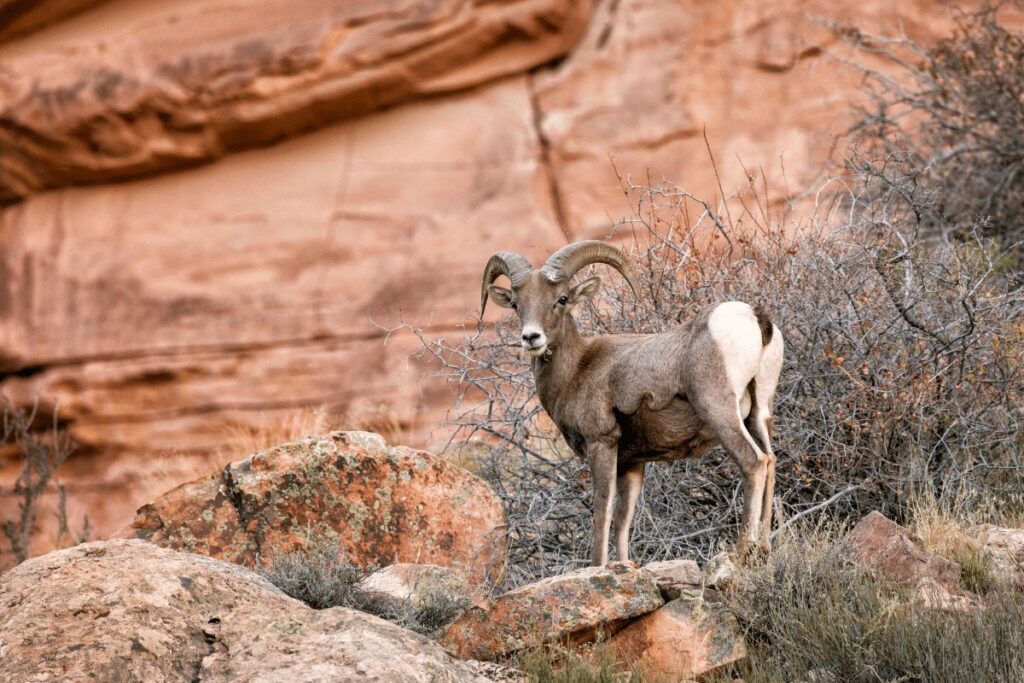
They can go without water for extended periods, getting the necessary hydration from the plants they consume.
Reptiles and Insects
Reptiles, including lizards and snakes, and various insects have also adapted to the desert heat.
Many are nocturnal, staying underground during the day to avoid the heat and emerging at night to hunt and feed.
Birdlife
Birdwatchers will also find much to admire in the Valley of Fire, with species like the Raven, Red-tailed Hawk, and the Roadrunner making their home here.
These birds have adapted to the desert conditions in a variety of ways, such as by finding shade and water, altering their activity patterns, and having efficient kidney systems.
Life in the Valley of Fire is a testament to the adaptability and resilience of nature. Despite the harsh desert conditions, these species have found ways to thrive, adding to the park’s rich biodiversity and providing visitors with a unique opportunity to witness the spectacular drama of life in the desert.
Little Known Facts about Valley of Fire State Park
The Valley of Fire State Park, with its fiery red sandstone formations and unique desert ecosystem, is a place of wonder and intrigue.
But beyond its well-known hiking trails and iconic landmarks, the park holds a trove of lesser-known facts that add to its allure.
Let’s delve into these fascinating facets that make the Valley of Fire even more captivating.
Hollywood’s Desert Backdrop
A Favorite Filming Location
The Valley of Fire’s otherworldly landscape has captured Hollywood’s imagination, serving as the backdrop for numerous films and TV shows.
From classic westerns to sci-fi adventures, the park’s dramatic scenery has graced both the big and small screen.
Star Trek’s Alien Landscape
In a memorable episode of Star Trek: The Original Series, the Valley of Fire stood in for the alien world of Capella IV.
Its exotic landscape provided the perfect setting for Captain Kirk and his crew’s interstellar adventures.
Valley of Fire and the Cosmos: Dark Sky Designation
A Dark Sky Park
The Valley of Fire isn’t just a place to explore earthly wonders; it’s also a gateway to the cosmos.
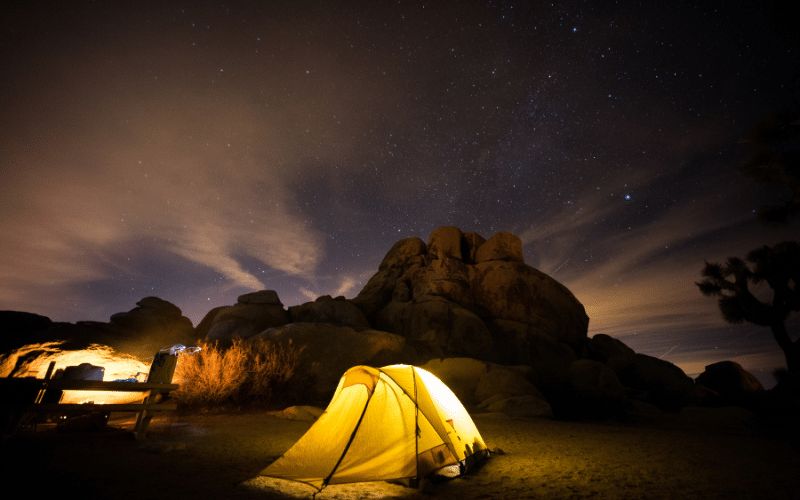
Thanks to its remote location and lack of light pollution, the park is an excellent spot for stargazing.
The Milky Way and Beyond
On clear nights, visitors can see the Milky Way stretching across the sky.
During certain times of the year, other celestial events, such as meteor showers and lunar eclipses, can also be witnessed.
The Park’s Involvement in Public Art and the Seven Magic Mountains
Art in the Desert
The Valley of Fire isn’t just a nature reserve; it’s also a hub for public art. The park’s rugged landscape has inspired many artists and has served as the canvas for several striking art installations.
The Seven Magic Mountains
The park’s most famous art installation is arguably the Seven Magic Mountains, a collection of brightly painted boulder totems that stand in stark contrast to the surrounding desert. This vibrant artwork, while not within the park’s boundaries but close by, adds a touch of human creativity to the natural beauty of the area.
The Hidden Wonders of Valley of Fire
The Park’s Namesake
Many people don’t know that the park’s name comes from the fiery red color of the sandstone formations, which appear to be on fire when reflecting the sun’s rays.
This phenomenon is especially striking at sunrise and sunset, casting a magical glow over the landscape.
Ancient Marine Fossils
Despite being a desert, the Valley of Fire was once underwater. Evidence of this can be found in the form of marine fossils embedded in the rocks, offering a glimpse into the area’s ancient past.
Tiny Cryptobiotic Soil Crusts
The desert floor is home to cryptobiotic soil crusts, a community of microorganisms that play a crucial role in preventing soil erosion and promoting plant growth.
These tiny life forms are a vital part of the desert ecosystem, proving that life in the Valley of Fire exists in many forms.
The Oldest State Park
Despite its timeless beauty, many visitors are unaware that the Valley of Fire holds the title of Nevada’s oldest and largest state park, having been dedicated in 1935. This fact only adds to its historical significance and charm.
Uncovering these little-known facts about the Valley of Fire enhances the sense of wonder and exploration that awaits within this extraordinary park.
Each revelation adds another layer to the story of this enchanting place, making each visit a unique adventure.
Essential Visitor Information
Planning a trip to the Valley of Fire State Park requires a bit of foresight. Knowing when to visit, understanding the park fees, and being aware of safety considerations can make your experience more enjoyable and ensure that you’re playing your part in preserving this precious environment.
When to Visit and How to Get There
The Valley of Fire is open all year round, but the best times to visit are in the spring and fall when temperatures are more moderate.
Summers can be extremely hot, with temperatures often exceeding 100°F (38°C), making outdoor activities challenging.
In contrast, winters are relatively mild but can be chilly, especially at night.
The park is conveniently located approximately 50 miles northeast of Las Vegas, making it an easy day trip for those visiting Sin City.
The drive takes about an hour via Interstate 15 and Valley of Fire Highway.
Park Fees and Camping Facilities
The entrance fee for the park is $10 per vehicle per day as of 2023, with slightly higher rates for camping.
The park offers two campgrounds: Atlatl Rock and Arch Rock, both providing shaded tables, grills, and restrooms.
Sites are available on a first-come, first-served basis, and the camping fee is $20 per night, plus an additional $10 for sites with utility hookups.
Also Read: VALLEY OF FIRE STATE PARK: 10 VISTAS WE EXPLORED! (WILDLIFE AND CAMPING INCLUDED)
Safety Considerations and Leave No Trace Principles
Safety is paramount when visiting the Valley of Fire. Always bring plenty of water, wear sun protection, and avoid strenuous activities during peak heat hours.
Also, be aware of wildlife, especially snakes, which can pose a hazard if disturbed.
Adhering to Leave No Trace principles is essential to preserve the park’s natural beauty.
These guidelines include staying on designated trails, disposing of waste properly, respecting wildlife, and not removing any natural or cultural features.
Conclusion
The Valley of Fire State Park is more than just a collection of stunning landscapes; it’s a testament to the power of nature and the resilience of life.
It’s a place where you can witness the raw beauty of the earth, explore the footprints of ancient cultures, and marvel at the adaptability of desert flora and fauna.


